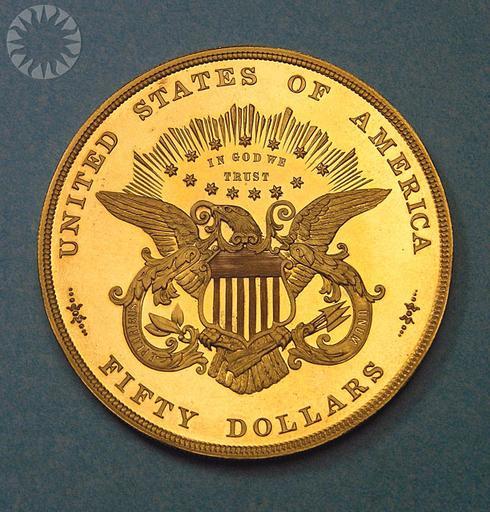MAKE A MEME
View Large Image

| View Original: | United_States,_50_Dollars,_1877_(pattern).jpg (612x640) | |||
| Download: | Original | Medium | Small | Thumb |
| Courtesy of: | www.flickr.com | More Like This | ||
| Keywords: legendary coins legendarycoins numismatics money smithsonian probably public domain probablypublicdomain round circle indoor SI Neg. 2005-27355. Date: 9/1/2005...Some twenty years after the private sector had abandoned the idea of a fifty-dollar gold piece in the mid-1850s, the Philadelphia Mint considered the possibility of a federal coin of this denomination. There was even talk of a "Union", or hundred-dollar coin, and a drawing or two has survived to suggest what the Mint had in mind. But in the end, no such coin was ever produced. .The project went a bit farther in the case of the "Half Union." Dies were prepared, the work of William Barber (father of the eventual Mint Chief Engraver Charles E. Barber). .Barber's obverse and reverse designs look vaguely akin to Longacre's work for the double eagle. A few patterns were struck in copper and two in gold; the latter share a reverse die but each has a slightly different obverse die. The project was abandoned soon afterwards, as it became apparent that the new coin simply wasn't needed..Click here to view the reverse...Credit: Tom Mulvaney (Smithsonian Institution) SI Neg. 2005-27355. Date: 9/1/2005...Some twenty years after the private sector had abandoned the idea of a fifty-dollar gold piece in the mid-1850s, the Philadelphia Mint considered the possibility of a federal coin of this denomination. There was even talk of a "Union", or hundred-dollar coin, and a drawing or two has survived to suggest what the Mint had in mind. But in the end, no such coin was ever produced. .The project went a bit farther in the case of the "Half Union." Dies were prepared, the work of William Barber (father of the eventual Mint Chief Engraver Charles E. Barber). .Barber's obverse and reverse designs look vaguely akin to Longacre's work for the double eagle. A few patterns were struck in copper and two in gold; the latter share a reverse die but each has a slightly different obverse die. The project was abandoned soon afterwards, as it became apparent that the new coin simply wasn't needed..Click here to view the reverse...Credit: Tom Mulvaney (Smithsonian Institution) | ||||